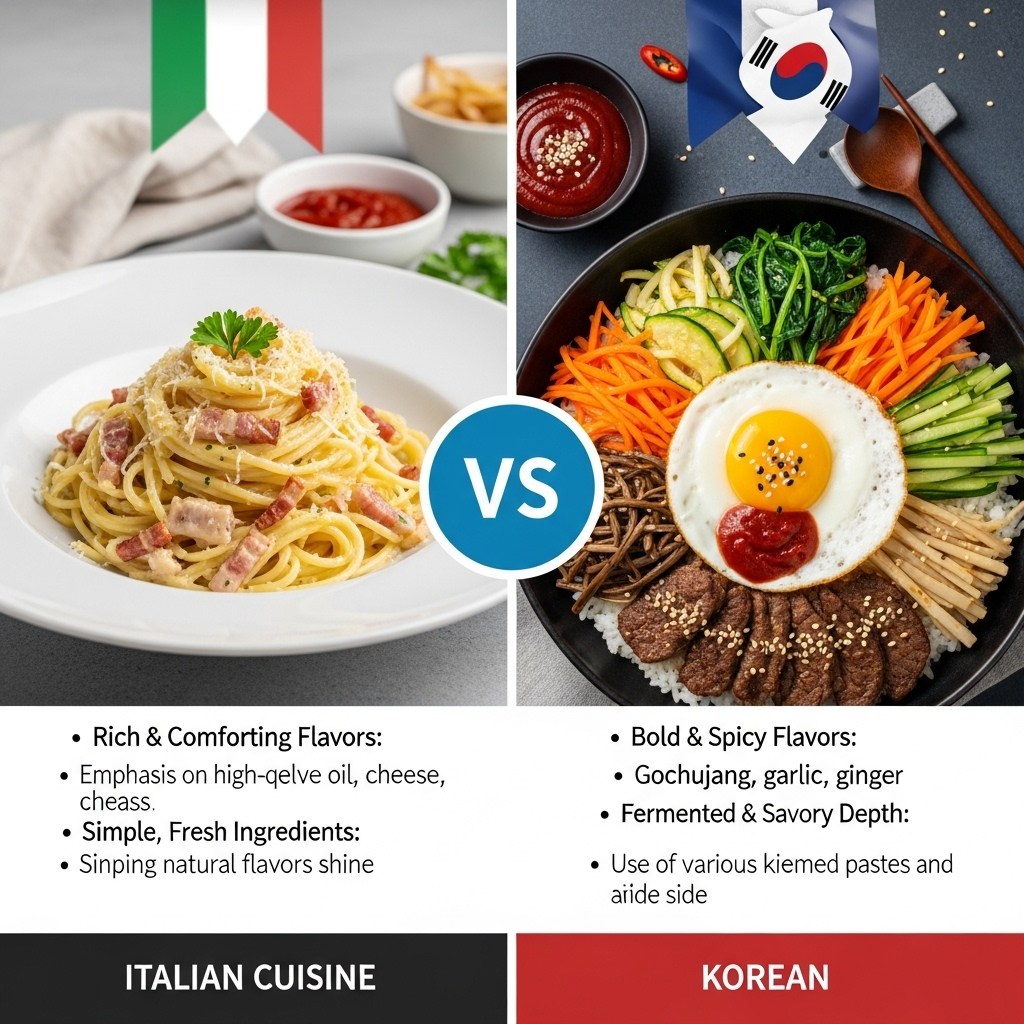Cuisine types: Italian vs. Korean
Quick Verdict
Both Italian and Korean cuisines offer diverse culinary experiences, with Italian focusing on fresh ingredients and regional variations, while Korean emphasizes spice and fermentation.
- Italian cuisine offers a wider range of regional variations and dairy usage.
- Korean cuisine is generally spicier and relies heavily on fermentation.
- Both cuisines offer vegetarian and vegan options, but Italian cuisine may be more readily available.

Key features – Side-by-Side
| Attribute | Italian | Korean |
|---|---|---|
| Spice Level | — | Known for spiciness due to gochugaru, but spice levels vary. |
| Common Protein Sources | — | Beef, chicken, pork, seafood (fish, shellfish), and tofu. |
| Typical Carbohydrates | — | Rice is primary. Noodles, including wheat and glass noodles, are also frequently used. |
| Use of Dairy | — | Not a significant part of traditional Korean cooking, but consumption has increased with Western-style foods. |
| Vegetarian Options | — | bibimbap (without meat), kongguksu, vegetable gimbap, japchae, various banchan. Many dishes can be adapted. |
| Vegan Options | — | Available, especially in larger cities. Some traditional sweets are vegan. Vegan versions of kimchi are available. Common dishes include vegetable gimbap, japchae, and certain banchan. |
| Average Cost per Meal | — | Casual eatery: $5 to $8 USD. Mid-range restaurant: $9 to $19 USD. Korean BBQ: $11 to $27 USD. Making Korean food at home: A meal averages £2.69 per portion. |
Overall Comparison
Spice: Korean is spicier; Dairy: Italian uses more; Vegetarian: Both have options; Cost: Korean can be more affordable.
Pros and Cons
Italian Cuisine
Pros:
- Wide variety of dishes and regional variations
- Many vegetarian options available
- Emphasis on fresh ingredients
- Can accommodate various dietary needs (inquire with the restaurant)
- Warm and inviting ambiance
Cons:
- Spice level may be low for some
- Vegan options may be less prevalent
- Authenticity can vary
- Portion sizes can vary
- Cost can vary widely
Korean
Pros:
- Wide variety of dishes beyond BBQ and bibimbap, such as kimchi jjigae, doenjang jjigae, tteokbokki, and japchae.
- Many dishes emphasize seasonal ingredients.
- Vegetarian and vegan options are available, especially in larger cities.
- Offers a range of cooking methods like fermentation, grilling, and steaming.
Cons:
- Spice levels can vary and may be too spicy for some.
- Dairy is not a significant part of traditional dishes.
- Communicating food allergies can be challenging.
- Some restaurants may not be allergy-aware or able to fully accommodate dietary restrictions.
User Experiences and Feedback
Italian Cuisine
What Users Love
- Use of fresh, high-quality ingredients is a hallmark of authentic Italian cooking.
- Italian cuisine can often accommodate vegetarian diets well with pasta dishes, pizzas, and vegetable-based entrees.
- Italian restaurants often aim for a warm, inviting, and elegant ambiance.
Common Complaints
- No major complaints reported.
Value Perception
- No value feedback reported.
Korean
What Users Love
- Authenticity depends on the restaurant and regional variations.
- Some dishes can be made gluten-free by substituting ingredients.
- Many Korean restaurants offer vegetarian-friendly dishes.
- Vegan options are increasingly available, especially in larger cities.
Common Complaints
- Spice level can vary; it's best to inquire and request milder versions if needed.
- Handling of food allergies can be challenging; clear communication is important.
- Some restaurants may not be able to fully accommodate allergy requests.
Value Perception
- Casual eatery: $5 to $8 USD per meal.
- Mid-range restaurant: $9 to $19 USD per meal.
- Korean BBQ: $11 to $27 USD per meal.
- Making Korean food at home: A meal averages £2.69 per portion.